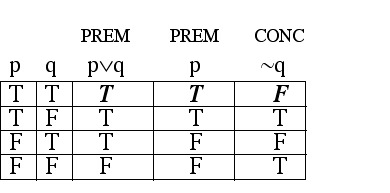EXAMPLE 2.3.9A
Test the validity of the following argument
I walk or I chew gum.
I'm walking.
Therefore, I'm not chewing gum.
EXAMPLE 2.3.9A SOLUTION
First, symbolize the argument.
Let p be the statement "I walk."
Let q be the statement "I chew gum."
Then the argument has this symbolic form:
![]()
Notice that although this form looks similar to Disjunctive Syllogism,
it is significantly different in the second premise and conclusion.
Since this form doesn't conform to any of the common patterns that we have
encountered so far, we must use a truth table.

Since in the first row we have both premises true while the conclusion is false, we see that this argument is INVALID.